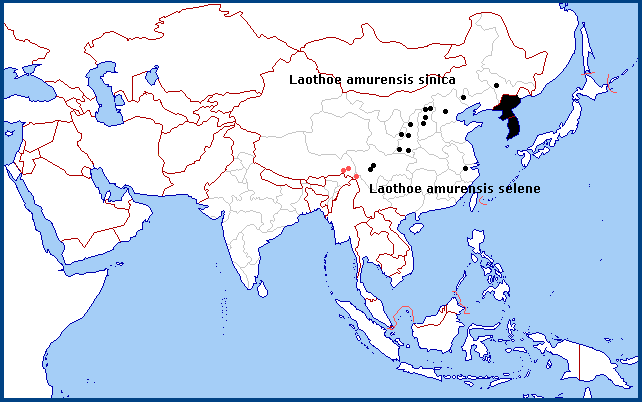

Laothoe selene Zolotuhin, 2018, Eversmannia (54): 11. Type locality: China, NW Yunnan, Lijing/Zhongdian [Lijiang/Shangri-La], near Tuguancun, 27°29.7'N 99°53.7'E, 24-25.v.2012, 3200m.
Synonym. Laothoe eitschbergeri Zolotuhin, 2018. An inadvertent nomen nudum due to a typographical error. This was probably the original name intended for the taxon described as Laothoe selene.
Note. This taxon was given specific status based on a 1.9-2.3% DNA barcode difference from Laothoe amurensis sinica and a 2.5% difference from Laothoe amurensis amurensis. The latter itself differs from Laothoe amurensis sinica by 2.5-2.8% (Zolotuhin, 2018). Given that natural variation within clearly defined taxa of the Smerinthini can vary up to 3% or more, a variation of 3.5-4% is required before a population can be considered a new species. A difference of 3% or less indicates either a new subspecies or just natural variation within a given population.
In terms of appearance, Laothoe selene was said to differ in a larger size, the relatively slender but strongly apically broadened forewing, a well-defined pattern of transverse lines and bands, and a forewing antemedial band angled on vein 1A. Examination of four specimens from Yunnan in NHMUK, together with six moths on the BOLD website, showed that while generally true (except for the antemedial band shape, which is straight in most specimens observed), there is nevertheless still overlap in these characters with specimens from Sichuan, Shannxi and the Russian Far East, and all four populations are highly variable.
Wingspan: 100-114mm. Although larger, it resembles Laothoe amurensis sinica and, like that subspecies, lacks a rust-red patch at the base of the hindwing. However, the more pronounced wavy lines/bands running across both sets of wings make this taxon resemble Laothoe habeli Saldaitis, Ivinskis & Borth, 2010, which has a rust-red patch at the base of the hindwing.
Little is known about the behaviour of this subspecies except that males are strongly drawn to light. In Yunnan it is generally found above 2500m, often as high as 4000m, but with the odd individual at lower altitudes.
China: 24-25.v (Shangri-La); 10.vii (Adunzi, nr Dêqên (Deqing/Dêqên County, Diqing Tibetan Autonomous Prefecture/Dêqên Autonomous Prefecture)); vii (Lijiang).
OVUM: Information not available.
LARVA: Information not available.
PUPA: Information not available.
Larval hostplants. Information not available, but probably various species of Salix and Populus.
Unknown.
China: Yunnan (Adunzi, nr Dêqên (Deqing/Dêqên County, Diqing Tibetan Autonomous Prefecture/Dêqên Autonomous Prefecture), 4000m; Dabaoshan, Huaping County; Shangri-La; Lijiang, 2630m); Xizang/Tibet (Mutu, Namjagbarwa region, 850m; Bomi, 2750m; Qamdo).
Endemic to China (Yunnan and eastern Xizang/Tibet).

Holarctic; eastern Palaearctic region. Pleistocene refuge: Polycentric -- Sinotibetan and Yunnan refugia.
 Return to Sphingidae of the Eastern Palaearctic species list
Return to Sphingidae of the Eastern Palaearctic species list